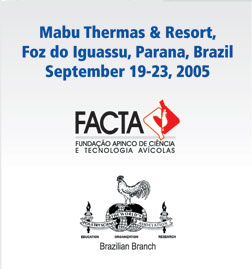Contributed Papers: Oral Presentations
Diagnosis and Epidemiology |
Detection
and identification of Neospora caninum in a naturally
infected buffalo fetus (Bubalus bubalis)
from Brazil
Aline A. R. Rodrigues,
Rodrigo M. Soares,
Daniela P. Chiebao, Solange M. Gennari*
Departamento de Medicina Veterinária Preventiva
e Saúde Animal, Faculdade de Medicina Veterinária
e Zootecnia, Universidade de São Paulo, Av.
Prof. Orlando Marques de Paiva, 87,
Cidade Universitária, São Paulo, SP,
CEP 05508-000.
* Author for correspondence: Phone: +551130917654,
Fax: +551130917928, sgennari@usp.br (S. M. Gennari)
The water buffalo
(Bubalus bubalis) is an important natural host for
Neospora caninum. In this study, we aimed at detecting
and identifying N. caninum from fetuses obtained from
pregnant water buffaloes sacrificed at slaughterhouse
in order to confirm the congenital transmission of
the parasite in this intermediate host. Specimens
of brain and thoracic fluid from nine fetuses with
gestational ages ranging from two to five months were
obtained from females water buffaloes raised under
grazing condition. The brain specimens of one fetus
proved positive by two PCR assays, one of them directed
to Neospora-specific Nc5 gene and the other to the
common toxoplasmatiid ITS-1 sequence. The PCR products
of gene 5 and ITS-1 were sequenced and revealed the
identity of PCR products, which were confirmed as
N. caninum. All fetal fluid samples examined by indirect
fluorescent antibody test were negative for the presence
of N. caninum antibodies (antibody titer < 25).
The absence of antibodies in the N. caninum positive
fetus may be due to lack of fetal immunocompetence,
or a short interval between infection and sample collection.
In bovine fetuses younger than six months, lack of
fetal immunocompetence may explain the low sensitivity
of fetal serology for the detection of N. caninum
infection. In conclusion, this is the first detection
and molecular identification of N. caninum in fetuses
of naturally infected water buffaloes, and confirms
the serological observations that many of these animals
may already be infected at calving, and also that
congenital transmission of N. caninum occurs in buffaloes.
However, the actual role played by this protozoan
as a causative agent of reproductive disorders in
buffaloes remains to be elucidated.
